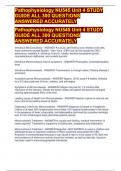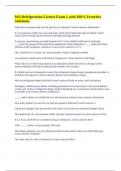Pathophysiology NU545 Unit 4 STUDY
GUIDE ALL 300 QUESTIONS
ANSWERED ACCURATELY
Pathophysiology NU545 Unit 4 STUDY
GUIDE ALL 300 QUESTIONS
ANSWERED ACCURATELY
Infectious Mononucleosis - ANSWER-An acute, self-limiting viral infection of B cells,
most commonly caused Epstein - Barr Virus ( EBV) but can be caused by CMV,
adenovirus, hepatitis A, influenza A and B, rubella, bacteria toxoplasma gondii,
corynebacterium diptheriae, and coxiella burnetii.
Infectious Mononucleosis triad of symptoms - ANSWER-Pharyngitis, lymphadenopathy,
fever
Infectious Mononucleosis - ANSWER-Transmission is through saliva ("kissing disease")
and blood
Incubation period Mononucleosis - ANSWER-Approx. 30-50 days/4-8 weeks, followed
by a 3-5 day prodrome of fever, malaise, and arthralgias.
Symptoms of Mononucleosis - ANSWER-Fatigue may last for 1-2 months after
resolution of the infection. Rarely the lymph nodes and spleen will become enlarged
causing splenomegally 50% of the time.
Leading cause of death from Mononucleosis - ANSWER-Splenic rupture is rare but can
occur and is the leading cause of death.
Diagnostic Criteria for Mononucleosis - ANSWER-Diagnosis is based on Hoagland's
criteria of at least 50% lymphocytes and at least 10% atypical lymphocytes in the blood
in the presence of fever, pharyngitis, and adenopathy confirmed by a positive serologic
test. 5-15% of Monospot tests yield false-positive results.
Mononucleosis Treatment - ANSWER-Is usually self-limiting, medical intervention is
rarely required. Treatment is supportive including rest, analgesics and antipyretics.
Mononucleosis Treatment - ANSWER-Ibuprofen, NOT ASPIRIN, is used in children and
adolescents due to reported incidence of Reye syndrome associated with EBV.
Ampicillin is contraindicated because it can cause a rash in most cases of IM. Bed rest
and avoidance of strenuous activity should be included, as well as steroids. Acyclovir
has been used in immunosuppressed individuals.
,Pathophysiology NU545 Unit 4 STUDY
GUIDE ALL 300 QUESTIONS
ANSWERED ACCURATELY
Leukemia - ANSWER-an uncontrolled proliferation of malignant leukocytes, causing an
overcrowding of bone marrow and decreased production and function of normal
hematopoietic cells.
Leukemia - ANSWER-classified by its predominant cell of origin (myeloid or lymphoid)
and the rate of progression (chronic or acute).
Four types of Leukemia - ANSWER-Acute lymphocytic (ALL), acute myelogenous
(AML), chronic lymphocytic (CLL), and chronic myelogenous (CML).
Leukemia - ANSWER-White children have higher rates of occurrence. ALL is the least
common overall but is the most common in children.
Leukemia Patho - ANSWER-Blasts "crowd out" bone marrow and cause cellular
proliferation of the other cell lines to decrease, possibly resulting in pancytopenia
(reduction in all cellular components of blood).
Acute Lymphocytic Leukemia - ANSWER-• most common childhood leukemia
• greater than 30% lymphoblasts in bone marrow or blood
• genetic anomaly - Philadelphia chromosome (between chromosomes 9 and 22)
• risk factors: prenatal x-ray exposure, postnatal exposure to high-dose radiation, viral
infections with HTLV-1 (can cause rare form of ALL and EBV), Down syndrome
Acute Myelogenous Leukemia - ANSWER-• most common adult leukemia
• Down syndrome increases risk
• caused by abnormal proliferation of myeloid precursor cells, decreased rate of
apoptosis, arrest in cellular differentiation, mutation in the receptor tyrosine kinase FLT3
• risk factors include exposure to radiation, benzene, chemotherapy, hereditary
conditions
Manifestations of Acute Leukemia - ANSWER-• fatigue from anemia
• bleeding from thrombocytopenia (reduced platelets)
• fever from infection
• anorexia, weight loss, diminished sensitivity to sweet and sour tastes, muscle wasting,
difficulty swallowing
• CNS involvement
Treatment of Acute Leukemia - ANSWER-• chemotherapy
• supportive measures (blood transfusions, abx, antifungals, antivirals)
• allopurinol which prevents production of uric acid (which is elevated from cellular death
due to treatment)
• stem cell transplantation
, Pathophysiology NU545 Unit 4 STUDY
GUIDE ALL 300 QUESTIONS
ANSWERED ACCURATELY
• bone marrow transplant
Complications of Acute Leukemia - ANSWER-• anemia (treatment: blood products)
• neutropenia (treatment: granulocyte colony-stimulated factor G-CSF or granulocyte
macrophage colony stimulating factor GM-CSF)
• low WBC count (treatment: colony-stimulating factors to prevent infections)
Chronic Lymphocytic Leukemia - ANSWER-• affects monoclonal B lymphocytes
• has familial tendency
• is common in adults > 50 yrs
Chronic Myelogenous Leukemia - ANSWER-• usually diagnosed in adults
• is a meloproliferative disorder that also includes polycythemia vera, primary
thrombocytosis, and idiopathic myelofibrosis
• Philadelphia chromosome often present
Manifestations of CLL - ANSWER-•advances slowly and insiduously
• asymptomatic at the time of diagnosis; lymphadenopathy is the most common finding;
suppresses humoral immunity, increases infection with encapsulated bacteria
Manifestations of CML - ANSWER-• advances slowly and insiduously
infections, fever, weight loss; chronic phase (2-5 years, symptoms may not be
apparent); accelerated phase (6-18 months, primary symptom is splenomegaly);
terminal blast phase ("blast crisis", survival only 3-6 months)
Treatment for Chronic Leukemia - ANSWER-• chlorambucil, administered with or
without corticosteroids, on a daily or intermittent schedule
• chemotherapy
• no cure for CML (combined chemotherapy, biologic response modifiers, allogenic stem
cell transplantation)
Multiple Myeloma - ANSWER-A plasma cell malignancy and is a slow proliferating
cancer of the bone marrow. They secrete large amounts of proteins that resemble intact
immunoglobulins.
Multiple Myeloma - ANSWER-Occurs about twice as much in blacks as in whites and
rarely occurs before the age of 40 with the peak being around 70.
Manifestations of Multiple Myeloma - ANSWER-Hypercalcemia, renal failure,
Proteinuria, anemia, bone lesions, Confusion, headaches, and blurred vision.
Destruction of bone tissue causes pain, the most common presenting symptom.





